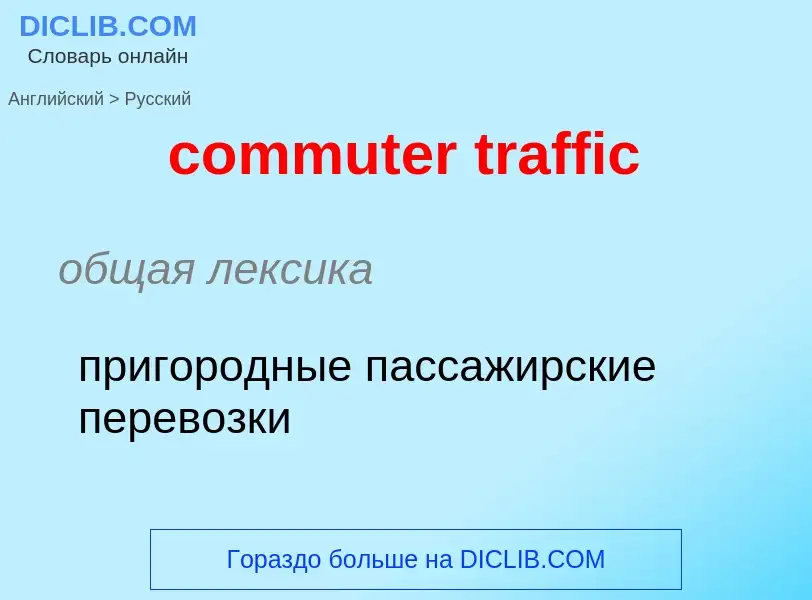Tradução e análise de palavras por inteligência artificial ChatGPT
Nesta página você pode obter uma análise detalhada de uma palavra ou frase, produzida usando a melhor tecnologia de inteligência artificial até o momento:
- como a palavra é usada
- frequência de uso
- é usado com mais frequência na fala oral ou escrita
- opções de tradução de palavras
- exemplos de uso (várias frases com tradução)
- etimologia
commuter traffic - tradução para russo
общая лексика
пригородные пассажирские перевозки
общая лексика
правило уличного движения
общая лексика
дорожное движение
строительное дело
автомобильное движение
Definição
Wikipédia

Commuting is periodically recurring travel between one's place of residence and place of work or study, where the traveler, referred to as a commuter, leaves the boundary of their home community. By extension, it can sometimes be any regular or often repeated travel between locations, even when not work-related. The modes of travel, time taken and distance traveled in commuting varies widely across the globe. Most people in least-developed countries continue to walk to work. The cheapest method of commuting after walking is usually by bicycle, so this is common in low-income countries, but is also increasingly practised by people in wealthier countries for environmental and health reasons. In middle-income countries, motorcycle commuting is very common. The next technology adopted as countries develop is more dependent on location: in more populous, older cities, especially in Eurasia mass transit (rail, bus, etc.) predominates, while in smaller, younger cities, and large parts of North America and Australasia, commuting by personal automobile is more common. A small number of very wealthy people, and those working in remote locations around the world, also commute by air travel, often for a week or more at a time rather than the more typical daily commute. Transportation links that enable commuting also impact the physical layout of cities and regions, allowing a distinction to arise between mostly-residential suburbs and the more economically focused urban core of a city (process known as suburban sprawl), but the specifics of how that distinction is realized remain drastically different between societies, with Eurasian "suburbs" often being more densely populated than North American "urban cores".


![Commuters on the [[New York City Subway]] during [[rush hour]] Commuters on the [[New York City Subway]] during [[rush hour]]](https://commons.wikimedia.org/wiki/Special:FilePath/NYC subway riders with their newspapers.jpg?width=200)
![Traffic jam]] in [[Baltimore]], [[Maryland]] Traffic jam]] in [[Baltimore]], [[Maryland]]](https://commons.wikimedia.org/wiki/Special:FilePath/Trafficjam.jpg?width=200)
.jpg?width=200)
![One-way traffic on Anawrahta road, [[Yangon]] One-way traffic on Anawrahta road, [[Yangon]]](https://commons.wikimedia.org/wiki/Special:FilePath/Anawrahta road traffic.jpg?width=200)
![Michigan Avenue]] in Chicago, Illinois Michigan Avenue]] in Chicago, Illinois](https://commons.wikimedia.org/wiki/Special:FilePath/Chicago 2007-4.jpg?width=200)
![Congestion in [[St. Louis, Missouri]], early 20th century Congestion in [[St. Louis, Missouri]], early 20th century](https://commons.wikimedia.org/wiki/Special:FilePath/George Bosche Produce Company wagon pulling out into traffic on Broadway near the corner of Cerre Street.jpg?width=200)
![This intersection in [[San Jose, California]] has crosswalks, left-turn lanes, and [[traffic light]]s. This intersection in [[San Jose, California]] has crosswalks, left-turn lanes, and [[traffic light]]s.](https://commons.wikimedia.org/wiki/Special:FilePath/Intersection 4way overview.jpg?width=200)
![An example of a typical rail crossing in the United States as an [[Amtrak]] Carolinian and Piedmont train passes through An example of a typical rail crossing in the United States as an [[Amtrak]] Carolinian and Piedmont train passes through](https://commons.wikimedia.org/wiki/Special:FilePath/NC train through Elon.jpg?width=200)
![[[Roundabout]] in a country where traffic drives on the right. Traffic streams circularly around a central island after first yielding to circulating traffic. Unlike with traffic circles, vehicles on a roundabout have priority over the entering vehicle, [[parking]] is not allowed and pedestrians are usually prohibited from the central island. [[Roundabout]] in a country where traffic drives on the right. Traffic streams circularly around a central island after first yielding to circulating traffic. Unlike with traffic circles, vehicles on a roundabout have priority over the entering vehicle, [[parking]] is not allowed and pedestrians are usually prohibited from the central island.](https://commons.wikimedia.org/wiki/Special:FilePath/NonUK Roundabout 8 Cars.gif?width=200)
![Traffic slows to a crawl on the [[Monash Freeway]] in [[Melbourne]], Australia through [[peak hour]] traffic. Traffic slows to a crawl on the [[Monash Freeway]] in [[Melbourne]], Australia through [[peak hour]] traffic.](https://commons.wikimedia.org/wiki/Special:FilePath/Peak hour traffic in melbourne.jpg?width=200)


